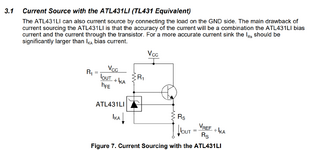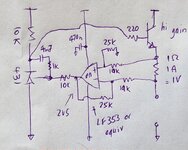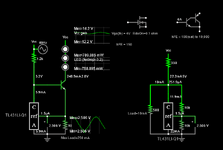engr_joni_ee
Advanced Member level 3

I am considering the attached circuit TL431 as a current source. I am wondering how do we solve Iout ?
I found this circuit at Figure 7 under the link
https://www.ti.com/lit/an/snoaa46/snoaa46.pdf
The datasheet of TL431 can be found from here.
https://www.ti.com/product/TL431LI-Q1/part-details/TL431LIAEDBZRQ1
Iout = Vref/Rs + Ika
If Rs = 100 Ohm
Vref = 2.495 V (according to datasheet)
What is the value of Ika ?
How do we chose R1 ? If depend on Vcc, Iout, hfe, Ika. What is hfe ? Is that related to transistor NPN shown in the circuit ?
I found this circuit at Figure 7 under the link
https://www.ti.com/lit/an/snoaa46/snoaa46.pdf
The datasheet of TL431 can be found from here.
https://www.ti.com/product/TL431LI-Q1/part-details/TL431LIAEDBZRQ1
Iout = Vref/Rs + Ika
If Rs = 100 Ohm
Vref = 2.495 V (according to datasheet)
What is the value of Ika ?
How do we chose R1 ? If depend on Vcc, Iout, hfe, Ika. What is hfe ? Is that related to transistor NPN shown in the circuit ?




